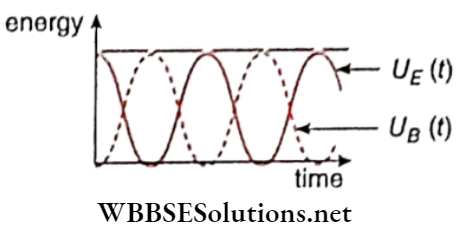Physics Electromagnetic Induction And Alternating Current
Alternating Current Long Questions And Answers
Question 1. In an oscillating LC circuit the maximum charge on the capacitor is Q. When the charge Is stored equally between the electric and magnetic fields, what Is the charge on the capacitor?
Answer:
Maximum charge of the capacitor = Q
So total energy of the circuit = \(\frac{1}{2} \frac{Q^2}{C}\)
When the’ chat ge of the capacitor is q, then the energy stored in the electric field is \(\frac{1}{2} \frac{q^2}{C}\). At this stage energy stored in the magnetic field is \(\frac{1}{2} L i^2\).
If it is \(\frac{1}{2} \frac{q^2}{C}\), equal to the total energy
= \(\frac{1}{2} \frac{q^2}{C}+\frac{1}{2} L i^2=\frac{1}{2} \frac{q^2}{C}+\frac{1}{2} \frac{q^2}{C}=\frac{q^2}{C}\)
so, \(\frac{q^2}{C}=\frac{1}{2} \frac{Q^2}{C} \quad \text { or, } q^2=\frac{Q^2}{2} \quad \text { or, } q=\frac{Q}{\sqrt{2}}\)
Question 2. In an LCR circuit, capacitance is changed from C to 2C. For the resonant frequency to remain unchanged what should be the change in the value of inductance L?
Answer:
Resonant frequency \(f_0=\frac{1}{2 \pi \sqrt{L C}}\)
For f0 to be constant, LC = constant.
If C is made 2C and the changed value of L is L’
then, \(L C=L^{\prime} \cdot 2 C \quad \text { or, } L^{\prime}=\frac{L}{2}\)
Question 3. If the emf of an ac circuit is E = E0 sin ωt and current I = I0 cos ωt, what is the power dissipated in the circuit?
Answer:
∴ \(E=E_0 \sin \omega t ; I=I_0 \cos \omega t=I_0 \sin \left(\omega t+90^{\circ}\right)\)
So, phase difference, θ = 90°
Therefore, power factor = cos θ – cos90° = 0
i.e., power dissipated = 0
Question 4. What should be the nature of the graph of the impedance Z concerning frequency in an alternating LCR circuit?
Answer:
If f is the frequency, ω = 2πf
Impedance, \(Z=\sqrt{R^2+\left(\omega L-\frac{1}{\omega C}\right)^2}\)
If frequency, \(f_0=\frac{1}{2 \pi \sqrt{L C}}\)
then \(\omega_0=2 \pi f_0=\frac{1}{\sqrt{L C}} \quad \text { or, } \omega_0 L=\frac{1}{\omega_0 C}\).
Under this condition Z is minimum, i.e., Z = R.
If the frequency increases or decreases concerning this resonant frequency f0, Z will vary accordingly, as shown.
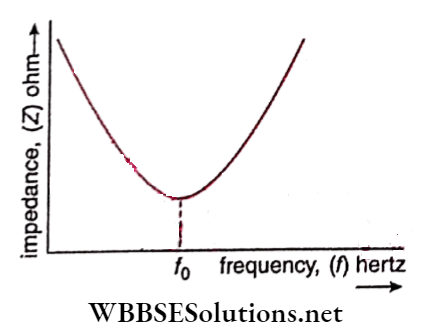
Question 5. How does the wattless current conform to the principle of energy conservation?
Answer:
An alternating current through a pure inductor or pure capacitor is witnessed, which means that no part of the input energy is lost due to heating.
Instead, the electrical energy supplied from the alternating source is stored in the magnetic field of the inductor or the electrostatic field of the capacitor.
Because of this stored energy, the current continues to flow in the circuit, even if the alternating spruce is removed from the circuit.
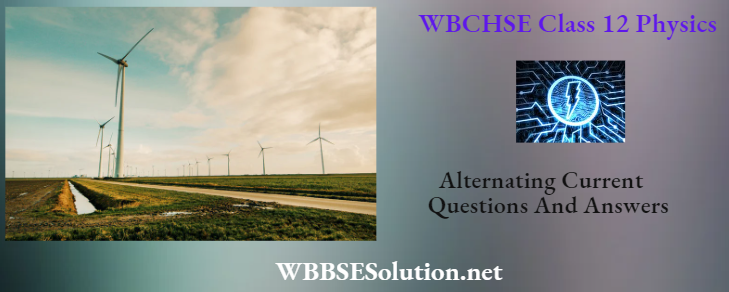
Question 6. The current through a circuit is given by \(I=I_0 \sin (\omega t+\pi / 6)\) when the applied emf is V = V0sinωt. Find the power dissipated in the circuit in one complete cycle. Draw the. phasor diagram for the given current and voltage. What are the possible two elements in the circuit?
Answer:
Here, the current leads the voltage by a phase angle, \(\theta=\frac{\pi}{6}\)
So, the power dissipated in one complete cycle
∴ \(P=V_{\mathrm{rms}} I_{\mathrm{rms}} \cos \theta=\frac{V_0}{\sqrt{2}} \frac{I_0}{\sqrt{2}}\cos \frac{\pi}{6}\)
= \(\frac{1}{2} V_0 I_0 \cdot \frac{\sqrt{3}}{2}=\frac{\sqrt{3}}{4} V_0 I_0\)
This shows the phase relation for the given current and; voltage.
If the circuit contains two elements only, then these are a pure resistor R and a capacitor C, because the current leads the voltage in a CR circuit.
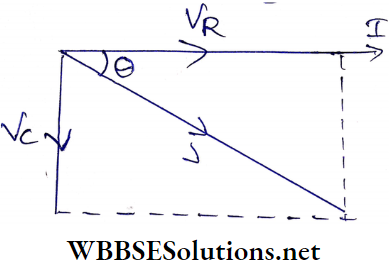
Question 7. How does the resistance R change with the change in frequency of AC? Show graphically.
Answer:
As R is independent of frequency (f), the nature of the graph is a straight line, parallel to the frequency axis.
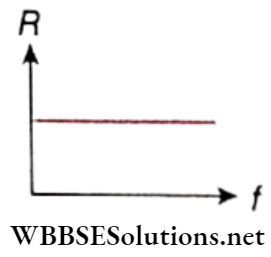
Question 8. Sketch a graph to show how the reactance of an inductor varies as a function of frequency.
Answer:
We know, \(X_L=\omega L=2 \pi f L\) [∵\(f=\frac{\omega}{2 \pi}\)]
where f is the frequency of ac supply. For a given coil, L is constant.
∴ \(X_L \propto f\)
So, Inductive reactance is directly proportional to the frequency of the current. Thus f-XL graph is a straight line passing through the origin.
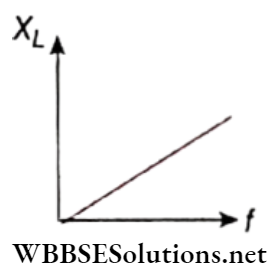
Question 9. Sketch a graph to show how the reactance of a capacitor varies as a function of frequency.
Answer: We know, \(X_C=\frac{1}{\omega C}=\frac{1}{2 \pi f C}\) [∵ \(f=\frac{\omega}{2 \pi}\)]
For constant C, \(X_C \propto \frac{1}{f}\)
So, the capacitive reactance is inversely proportional to the frequency of the current. Thus, the f-XC graph is a rectangular hyperbola.
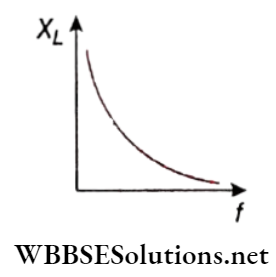
Question 10. How does an inductor behave in a dc circuit?
Answer:
An inductor, having a pure resistance R and a self-inductance L, has an impedance, \(Z=\sqrt{R^2+\omega^2 L^2}\) Here, ω = 2πf, where f = frequency of the electric source. Naturally, f = 0 for dc circuits; so, ω = 0, and Z = R.
This means that the inductor behaves as a pure resistance in dc circuits, whereas its inductance L, plays no role.
Question 11. The LC oscillations can be compared to mechanical oscillations of a block of mass m attached to a spring of force constant k. Explain.
Answer:
The LC oscillations are comparable to mechanical oscillations of a spring-mass system since both of them are simple harmonic motions.
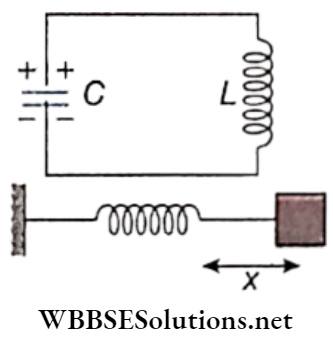
The general equation for the oscillation of a pure LC circuit,
∴ \(\frac{d^2 q}{d t^2}+\frac{q}{L C}=0\) → (1)
Again, the equation for the mechanical oscillation of a spring-mass system,
∴ \(\frac{d^2 x}{d t^2}+\omega_0^2 x=0\) → (2)
Where, \(\omega_0=\sqrt{\frac{k}{m}}\)
Comparing equations (1) and (2), we may write that the LC oscillations and the mechanical oscillations of the spring-mass system are analogous.
The analogy is given below in tabular form.
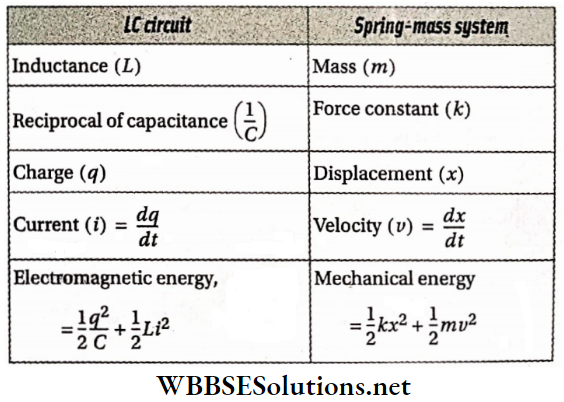
Question 12. In the given circuit, the switch K2 iS opened, and the switch If, is closed at time t = 0. At time t = t0, the switch K1 is opened, and the switch K2 is simultaneously closed. Sketch the variation of the inductor current I with time.
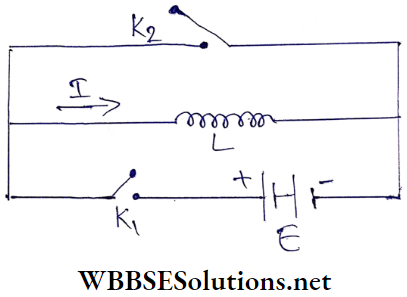
Answer:
Between time t = 0 and t = t0, the equation for the inductor current, \(L \frac{d I}{d t}=E \quad \text { or, } I=\frac{E}{L} t\)
For time t > t0, the equation for the inductor current,
∴ \(L\left(\frac{d I}{d t}\right)=0\)
or, \(I=I\left(t_0\right)=\frac{E t_0}{L} \text { (constant) }\)
Thus I increase linearly with a slope for t = 0 to t = t0.
For time t ≥ t0, I becomes a constant \(\left(=\frac{E t_0}{L}\right)\)
The variation of current (I) with time (t) is shown.
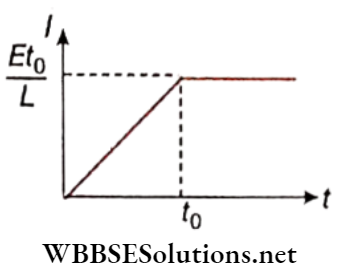
Question 13. Show that In the free oscillation of an LC circuit, the sum of energies stored In the capacitor and the Inductor is constant in time.
Answer:
Energy stored in the capacitor at time t,
⇒ \(U_E=\frac{q^2}{2 C}=\frac{q_m^2}{2 C} \cos ^2 \omega t\)
Energy stored in the inductor at time t,
⇒ \(U_B=\frac{1}{2} L I^2=\frac{L}{2}\left[q_m \omega \sin \omega t\right]^2\)
= \(\frac{q_m^2}{2} L \omega^2 \sin ^2 \omega t=\frac{q_m^2}{2 L C} L \sin ^2 \omega t=\frac{q_m^2}{2 C} \sin ^2 \omega t\)
Therefore total energy,
∴ \(U=U_E+U_B=\frac{q_m^2}{2 C}\left(\cos ^2 \omega t+\sin ^2 \omega t\right)=\frac{q_m^2}{2 C}\).
Therefore, for free oscillations of an LC circuit, the net energy remains constant at all times.
